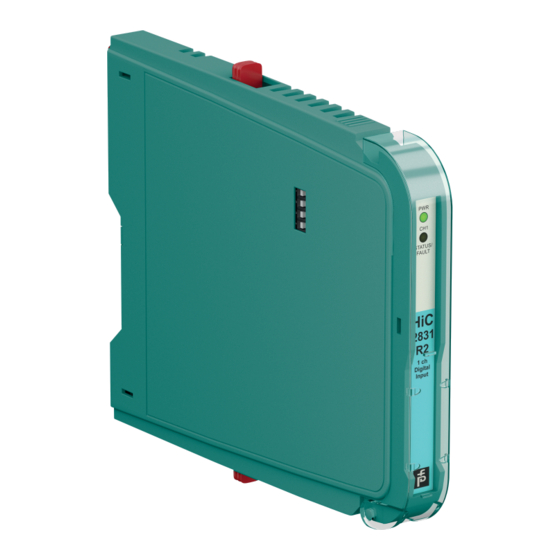Table of Contents
Advertisement
Quick Links
Function
This isolated barrier is used for intrinsic safety applications.
The device transfers digital signals (NAMUR sensors/mechanical contacts) from the explosion-hazardous area to the non-explosion-
hazardous area.
The input controls two passive transistor outputs with a resistive output characteristic.
The outputs have three defined states: 1-signal = 5 kΩ, 0-signal = 15 kΩ and fault > 100 kΩ.
This output characteristic offers line fault transparency on the signal lines.
Via switches the mode of operation can be reversed and the line fault detection can be switched off.
During a fault state, the passive transistor outputs switch to their fault state and LEDs indicate the fault according to NAMUR NE 44. A separate
fault bus is available. This fault bus can be monitored if the termination board supports a module fault detection.
This device mounts on a HiC termination board.
Application
This device is compatible to the control:
Honeywell CC-PDIL01
l
Compatibility check to other ESD/ DCS systems on request.
Connection
1.5 kΩ
10 kΩ
Zone 0, 1, 2
General specifications
Signal type
Functional safety related parameters
Refer to "General Notes Relating to Pepperl+Fuchs Product Information".
Pepperl+Fuchs Group
USA: +1 330 486 0002
www.pepperl-fuchs.com
pa-info@us.pepperl-fuchs.com
Switch Amplifier
HiC2831R2
<
1-channel isolated barrier
<
24 V DC supply (bus powered)
<
Dry contact or NAMUR input
<
Application-specific outputs
<
Usable as signal splitter (1 input and 2 outputs)
<
2 passive transistor outputs (resistive)
<
Line fault detection (LFD)
<
Line fault transparency (LFT)
<
Reversible mode of operation
<
Up to SIL 2 (SC 3) acc. to IEC/EN 61508
HiC2831R2
SL2
+
1
5a
-
4
5b
1a, 1b
2a, 2b
Termination Board
Digital Input
Germany: +49 621 776 2222
pa-info@de.pepperl-fuchs.com
SL1
8a
11
+
I
-
7a
14
10a
12
+
II
-
9a
15
-
24 V DC
+
Fault
6b
Zone 2
Singapore: +65 6779 9091
pa-info@sg.pepperl-fuchs.com
1
Advertisement
Table of Contents

Summary of Contents for Pepperl+Fuchs HiC2831R2
- Page 1 Zone 2 Technical Data General specifications Signal type Digital Input Functional safety related parameters Refer to "General Notes Relating to Pepperl+Fuchs Product Information". Pepperl+Fuchs Group USA: +1 330 486 0002 Germany: +49 621 776 2222 Singapore: +65 6779 9091 www.pepperl-fuchs.com pa-info@us.pepperl-fuchs.com...
- Page 2 12.5 x 106 x 128 mm (0.5 x 4.2 x 5.1 inch) (W x H x D) Mounting on termination board Refer to "General Notes Relating to Pepperl+Fuchs Product Information". Pepperl+Fuchs Group USA: +1 330 486 0002 Germany: +49 621 776 2222 Singapore: +65 6779 9091 www.pepperl-fuchs.com...
- Page 3 General information Supplementary information Observe the certificates, declarations of conformity, instruction manuals, and manuals where applicable. For information see www.pepperl-fuchs.com. Refer to "General Notes Relating to Pepperl+Fuchs Product Information". Pepperl+Fuchs Group USA: +1 330 486 0002 Germany: +49 621 776 2222 Singapore: +65 6779 9091 www.pepperl-fuchs.com...
- Page 4 The pins for this device are trimmed to polarize it according to its safety parameters. Do not change the setting. For further information see system description. Refer to "General Notes Relating to Pepperl+Fuchs Product Information". Pepperl+Fuchs Group USA: +1 330 486 0002...
- Page 5 ~ 4.5 mA (24 V, 250 ) ~ 1.5 mA < 0.1 mA Status/fault LED Refer to "General Notes Relating to Pepperl+Fuchs Product Information". Pepperl+Fuchs Group USA: +1 330 486 0002 Germany: +49 621 776 2222 Singapore: +65 6779 9091 www.pepperl-fuchs.com...














Need help?
Do you have a question about the HiC2831R2 and is the answer not in the manual?
Questions and answers